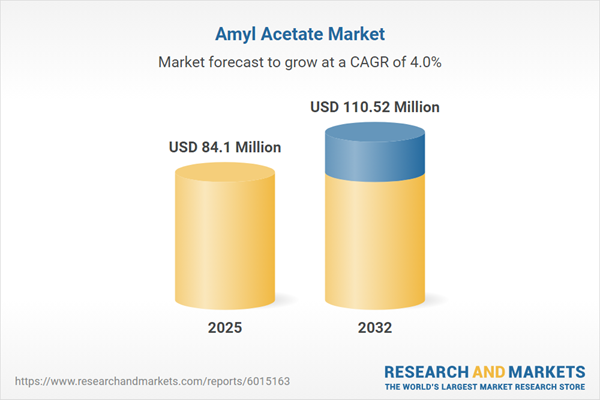Speak directly to the analyst to clarify any post sales queries you may have.
Amyl acetate is increasingly central to manufacturing and procurement strategies, as decision-makers seek solutions that drive operational efficiency and meet evolving sustainability standards. Its versatility across sectors helps organizations align their sourcing with both performance and compliance goals.
Market Snapshot: Growth Prospects in the Amyl Acetate Market
The amyl acetate market is progressing steadily, with expansion evidenced by a move from USD 80.91 million in 2024 to USD 84.10 million in 2025, projected to reach USD 110.52 million by 2032 at a CAGR of 3.97%.
Growth drivers include increased demand for high-performance solvents, more rigorous compliance criteria, and adoption of green chemistry. Regulatory initiatives are actively influencing procurement priorities, while applications span a range of manufacturing contexts such as adhesives and coatings, enabling consistency and improved environmental outcomes. Enterprises leveraging amyl acetate strengthen alignment with governance standards and progress toward ESG objectives.Scope & Segmentation: Comprehensive View of the Amyl Acetate Market
Designed for senior managers and procurement leaders, this analysis provides actionable insights into how the amyl acetate market is segmented for efficient sourcing, regulatory adaptation, and sustainable results. The following overview details the most relevant segments and dynamics:
- Applications: Solvent for adhesives in hot melt and pressure-sensitive formulations, paints and coatings for automotive and industrial applications, inks for flexographic and gravure printing processes, and textile processing, supporting throughput and consistent quality outcomes.
- End Use Industries: Key to processes in adhesives and sealants, paints and coatings, packaging, printing, textiles, and lamination or ink formulation, reflecting wide applicability across industrial markets.
- Purity Levels: Produced in industrial grades for manufacturing scale needs and reagent grades for precision-driven applications, giving procurement teams specification flexibility.
- Distribution Channels: Offered through direct sales and partnerships that support procurement agility and inventory consistency for buyers and suppliers.
- Regional Coverage: Present in developed and emerging markets, including the Americas, Europe, Middle East, Africa, and Asia-Pacific. Countries such as the United States, Germany, China, and India exhibit a range of regulatory models and supply chain approaches, fostering a mix of best practices.
- Companies Profiled: Major providers include Eastman Chemical Company, Celanese Corporation, Evonik Industries AG, BASF SE, Dow Inc., LANXESS AG, Mitsubishi Chemical Holdings Corporation, China Petroleum & Chemical Corporation, Saudi Basic Industries Corporation, and Arkema SA. These organizations offer technically advanced and stable product portfolios.
Key Takeaways: Strategic Insights for Senior Decision-Makers
- Amyl acetate’s rapid evaporation rate and robust solvent power streamline processes in adhesive formulation, coatings application, and printing, allowing manufacturers to enhance production cycles and adapt workflows efficiently.
- Advances in catalyst technology and process engineering are contributing to improved operational efficiency, providing opportunities to address sustainability objectives and cost management in parallel.
- Organizations are evolving supply chain strategies by building local manufacturing capacity and diversifying distribution, strengthening resilience and agility when navigating policy or market changes.
- Compliance with tightening VOC regulations is increasingly critical, particularly in sectors like automotive, textiles, and packaging that face intensified environmental expectations.
- Rising demand for high-purity amyl acetate, especially in electronics and other sectors where consistent performance defines competitive products, is influencing sourcing and quality assurance priorities.
Tariff Impact: Navigating U.S. Trade Fluctuations and Supply Chain Adaptations
Recent changes in U.S. tariff policy are shifting cost structures for companies relying on imported amyl acetate. Firms are responding by diversifying supplier networks and focusing on domestic sourcing to stabilize inventory levels and mitigate exposure to tariff-related financial risks. These adjustments promote greater market flexibility and support continuity against a backdrop of regulatory unpredictability.
Methodology & Data Sources
This report is based on direct interviews with stakeholders across the amyl acetate value chain and is supplemented by analysis of regulatory filings, sector-focused literature, and international trade data. Independent review ensures reliability for strategic decision-making.
Why This Report Matters
- Supplies procurement leaders with comprehensive intelligence to guide investments, enhance supply chain strategies, and ensure compliance, embedding sustainability along the value chain.
- Enables proactive identification of emerging opportunities and equips organizations to respond quickly to regulatory or regional changes impacting the specialty chemicals market.
- Delivers timely, relevant insight to help teams remain competitive as the sector evolves.
Conclusion
Amyl acetate’s role is adapting as industry leaders respond to shifts in regulation, technology, and procurement practices. This report equips decision-makers to refine sourcing strategies and support both efficient and sustainable operations as global market conditions change.
Additional Product Information:
- Purchase of this report includes 1 year online access with quarterly updates.
- This report can be updated on request. Please contact our Customer Experience team using the Ask a Question widget on our website.
Table of Contents
3. Executive Summary
4. Market Overview
7. Cumulative Impact of Artificial Intelligence 2025
Companies Mentioned
The companies profiled in this Amyl Acetate market report include:- Eastman Chemical Company
- Celanese Corporation
- Evonik Industries AG
- BASF SE
- Dow Inc.
- LANXESS AG
- Mitsubishi Chemical Holdings Corporation
- China Petroleum & Chemical Corporation
- Saudi Basic Industries Corporation
- Arkema SA
Table Information
| Report Attribute | Details |
|---|---|
| No. of Pages | 186 |
| Published | November 2025 |
| Forecast Period | 2025 - 2032 |
| Estimated Market Value ( USD | $ 84.1 Million |
| Forecasted Market Value ( USD | $ 110.52 Million |
| Compound Annual Growth Rate | 3.9% |
| Regions Covered | Global |
| No. of Companies Mentioned | 11 |









